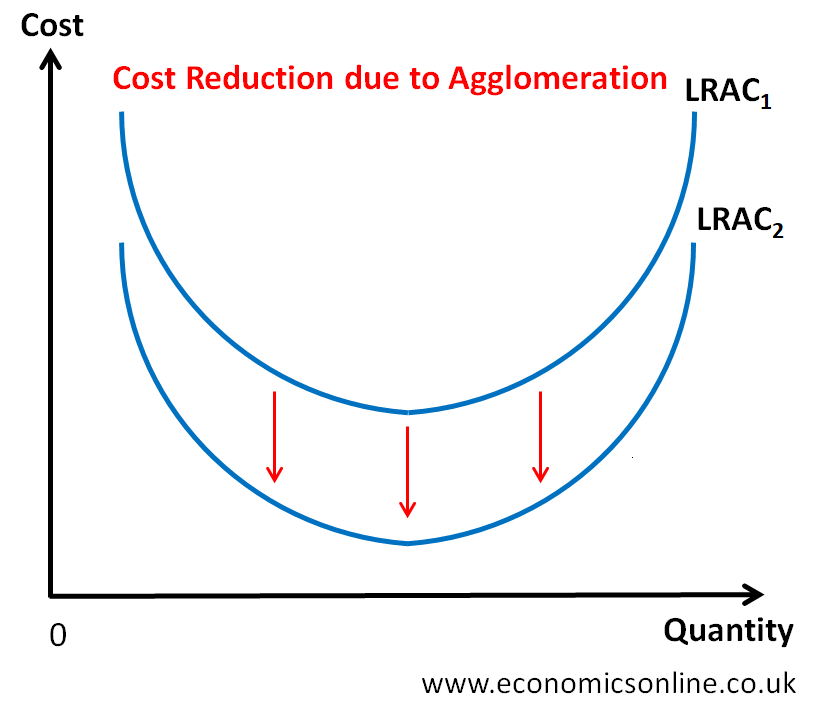
A black and white image of concentrated high-rise buldings with lights.
Agglomeration Economies
What are Agglomeration Economies?
Agglomeration economies refer to the cost advantages that firms and industries enjoy when they are located near one another. This proximity allows firms to benefit from various external economies of scale, resulting in increased productivity, innovation, and overall economic growth within a specific geographical area.
Understanding Agglomeration Economies
Agglomeration refers to the concentration of firms in one geographical area, whereas economies refer to the cost advantages enjoyed by firms due to their concentration. Agglomeration economies are efficiency gains for firms when they cluster in one place.
Agglomeration economies are mainly concerned with cost reductions. One example is that people and firms move closer to each other in industrial and urban clusters to avoid transport costs. This cost reduction is enjoyed by all firms, whether small or large. This is illustrated by the following diagram, which shows the reduction in long run average cost from LRAC1 to LRAC2 for all the firms due to agglomeration effect.

In addition to that, all the concentrated firms enjoy many other advantages that geographically dispersed firms cannot gain.
Aggregation economies existed at different geographic levels throughout history. The trend towards agglomeration can be found in the existence and development of cities, industrial areas, the formation of districts, and the crowding of related activities in a city neighbourhood.
Types of Agglomeration Economies
There are two primary types of agglomeration economies, each with its own unique characteristics and impacts:
Localisation Economies
Localization economies occur when firms in the same industry cluster together in a particular location. An example is the clustering of textile firms at one location. Here are the key features of localisation economies:
Knowledge Spillovers
When firms are in close proximity, the exchange of ideas and knowledge becomes more accessible, fostering innovation and creativity.
Specialised Labour Pool
A concentration of similar businesses attracts a specialised labour force, reducing search and recruitment costs for firms. This cost reduction due to labor pooling will benefit all the firms in the industry.
Supply Chain Efficiency
Suppliers and buyers are often located nearby, which leads to reduced transportation costs and quicker response times.
Urbanisation Economies
Urbanization economies occur when firms gain some advantages because of their location in a densely populated urban area such as the city center. The key features of urbanisation economies are:
Diverse Labour Pool
Urban areas offer a wide variety of skill sets and talents, enabling firms to find the right employees easily, quickly and with less cost.
Infrastructure and Services
Urban centers tend to have better infrastructure, access to financial services, and research institutions, facilitating business operations.
Networking Opportunities
Urban environments provide a hub for networking, collaboration, and partnerships, boosting business growth.
Advantages of Agglomeration
There are many agglomeration benefits, some of which are:
Labour
The concentration of similar firms in any one area leads to the creation of a local labour force including the skilled workers in various techniques used in the industry. Local colleges develop special courses of training geared to the particular needs of the industry leading to higher productivity and an increase in the human capital.
Ancillary Firms
In areas where there is a high degree of concentration of a particular industry, ancillary firms including service industries, catering for the needs of the dominant industry establish themselves and provide important business services. This will also improve the service sector in that area.
Disintegration
With agglomeration, there is a tendency for individual firms to specialise in a single process or in the manufacture of a single component. For example, in textile industry, the production of cloth is broken down into many processes, each carried out by a specialist firm including spinning, weaving, dyeing, finishing, etc.
Cooperation
Agglomeration encourages co-operation among the firms. A good example is provided by the research centers established as joint ventures by the firms located at one place. For example, the cotton firms in Lancashire have set up research center for their particular needs.
Geographical Advantages
According to the urban economics literature, firms and cities are likely to agglomerate where there are inherent geographic advantages. The benefits of this process occur when firms will realise cost advantages over their competitors.
Innovation
Clustering of similar businesses sparks innovation and technological advancements as firms learn from each other.
Job Creation
Agglomeration economies attract talent and foster job creation, boosting local employment rates and other economic activities.
Competitiveness
Agglomeration economies create competitive advantage by reducing costs of all the firms involved in agglomeration. Therefore, the firms in agglomerated regions tend to be more competitive on a global scale due to increased productivity and innovation.
Disadvantages of Agglomeration
There are some disadvantages of agglomeration which are as follows:
Inequality
Agglomerations can increase the gap between the rich and the poor regions and also heighten inter-regional inequality. This is due to the fact that the benefits of agglomeration economies are not always evenly distributed, leading to income disparities within regions.
Land Prices
A growing population increases the value of land and the government can tax the accumulated areas which may lead to higher land prices.
Pollution
Agglomeration economies cause pollution, which includes water pollution, air pollution, and land pollution. Due to the concentration of industry: the Yangtze River Delta has not only suffered from pollution but also from weather problems and many new diseases have also emerged.
Traffic Congestion
Traffic congestion is also a notable disadvantage of agglomeration economics. As firms and industries cluster together in urban areas, it often leads to heavy traffic during peak hours, resulting in increased commute times, economic costs in terms of lost productivity and higher operating expenses. Moreover, high population density can create pressure on infrastructure.

Increased Cost
Over agglomeration can result in higher demand of labour which may result in higher wages, leading to higher labour costs for all the firms. Increasing demands for raw materials may also bid up prices and cause costs to rise. Land for expansion many become increasingly scarce and hence more expensive both to purchase and to rent. Housing prices will also increase. Transport costs may also rise because of increased congestion due to high city population and high density. All firms in the industry, whether they are seeking to expand or not, may suffer rising costs as a result of too much agglomeration.
Real World Examples of Agglomeration Economies
There are many examples which proce the existence of agglomeration economies, some of which are as follows:
Silicon Valley, California, USA
The prime example of agglomeration economies is the Silicon Valley, in the United States, which is a renowned hub for technology and innovation companies, including giants like Apple, Google, and Facebook. The close proximity of these high-tech firms has created a rich ecosystem of knowledge sharing, talent pool access, and venture capital funding. This clustering and concentration of tech firms has led to rapid innovation and the establishment of countless startups, making it a prime example of agglomeration economies in the technology sector.
Bollywood, Mumbai, Bharat
Another example of agglomeration economies in the entertainment industry is Mumbai, the Bollywood capital of the world. Bollywood studios, film production companies, talent agencies, post-production facilities, and creative professionals are concentrated in this city. The close proximity of these entities has facilitated collaboration, creativity, and the rapid production of movies, making Mumbai a global leader in film production.
Fashion District, Milan, Italy
The third example of agglomeration economies is Milan's Fashion District, also known as the Quadrilatero della Moda, which is considered as a global fashion powerhouse. It has the headquarters and flagship stores of renowned fashion houses such as Prada, Gucci, and Versace. The district's concentration of fashion designers, manufacturers, and retailers creates a unique agglomeration economy. It allows for rapid trend diffusion, efficient supply chains, and access to skilled artisans, making Milan's status as a fashion capital.
The Importance of Agglomeration Economies
The economics of agglomeration has far-reaching impacts on businesses and regional development. Economies of agglomeration are the benefits that are not visible in the short run. But in the long run, these befits can be seen in the form of rising profits and increased competitive advantage. Cost savings are specially observed when the production becomes cheap leading to higher efficiency of all the firms in agglomeration. Moreover, the urban economists arguee that the agglomeration can increase the speed of innovation leading to the competitive and comparative advantage for firms involved.
Conclusion
In conclusion, the model of agglomeration is a powerful force that drives economic efficiencies, economic growth, innovation, and competitiveness in cities and regions around the world. This is specially true for large cities and larger cities. When firms are located at one geographical area, not only the area will develop but it will also contribute towards the development of a healthy economy. By harnessing the potential of agglomeration economies, we can create more prosperous and sustainable urban environments for the future.


